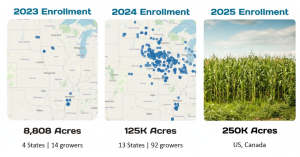Rootella Carbon expects sequestration of 1-4 tCO₂e per acre annually. In 2023, the average measured effect size was 3.89 tCO₂e per acre, measured across 8,808 treated and creditable acres in the US Midwest and Midsouth.
Rootella Carbon FAQ
Buyer FAQs
Buyer Benefits
Yes. Our solution ensures permanent carbon sequestration through soil particle aggregation and positive net flux. Mycorrhizae facilitate the formation of stable carbon compounds that remain in the soil for millennia, catalyzing the formation of Mineral Associated Organic Matter by 5-10 times. Ultimately, up to 60% of plant-derived SOC is attributed to mycorrhizal fungi.
Project-level durability is built into the Verra CDR buffer pool. To learn more about the permanence and durability of mycorrhizal carbon, see our white paper.
Yes. Rootella Carbon is administered through the Rootella Carbon Software Platform – our proprietary software platform that enables rapid scaling. The program expanded tenfold in 2024 in North America and doubled in 2025.
Rootella Carbon uniquely qualifies more growers by lowering additionality barriers, enabling stewards of the land to benefit from their investment in sustainable practices, and making mycorrhizae a cost-effective and accessible choice.
Rootella inoculants have been applied on a cumulative 13.7 million acres across 23 markets, including the US, Brazil, India, and China. In the US, Canada and Brazil, there are over 270M acres of low-till/no-till farms that are mostly ineligible for carbon credits without Rootella Carbon, and represent an immediate market.
Yes. Our initial projected credit issuance (100% CDR) includes:
- 2025: 20,000 tCO2e (vintage 2023)
- 2026: 150,000 tCO2e (vintage 2024)
- 2027: 300,000 tCO2e (vintage 2025)
Rootella Carbon is a Carbon Dioxide Removal (CDR) solution that leverages the natural power of mycorrhizal fungi in soil to permanently sequester carbon. Rootella Carbon growers sequester between 1-4 tCO₂e annually. Currently the program is 100% CDR. Future vintages may include emissions reduction.
How does mycorrhizal carbon work?
Rootella’s mycorrhizal fungi establish symbiosis with plant roots, effectively extending the root system by 10-100x in a vast underground network. This partnership allows plants to absorb vital soil nutrients more effectively, while providing carbohydrates to the fungi, which are then stored as carbon in the soil. Remarkably, up to 60% of plant-derived organic carbon can be attributed to mycorrhizae. By facilitating the formation of Mineral-Associated Organic Matter (MAOM), mycorrhizal carbon creates a stable carbon sink that is estimated to last for millennia. This relationship offers a range of benefits for growers, including enhanced crop yield, fertilizer savings, increased stress resistance and carbon sequestration. Learn more about how Rootella works here.
Rootella Carbon offers growers both agronomic and financial benefits.
In order to qualify for carbon credits, growers apply Rootella mycorrhizal inoculants as part of their participation in the Rootella Carbon Program. Growers receive end-to-end support from Groundwork BioAg and up to 70% of carbon credit net proceeds – a new revenue stream independent of commodity prices.
In addition to the financial benefits of carbon credit revenue, growers enjoy the significant agronomic benefits of mycorrhiza. These include:
- Enhanced crop yields due to better nutrient uptake
- Increased fertilizer savings (up to 50% reduction in phosphorus fertilizer use)
- Improved stress resistance, particularly against abiotic stressors such as drought, flooding, acidity and salinity
Yes, Rootella Carbon directly addresses four key SDGs. Across the 13.7M acres where Rootella has been applied (cumulatively), we estimate the following impact:
- #2: Zero Hunger: Additional 10 Kcal, equivalent to enough food for 12 million more people for one year
- #13 Climate Action: 27 MtCO2e sequestered (est.), equal to the annual emissions from 5.8M cars
- #14 Life below Water: 23 kT of P runoff avoided, or 4.2% of annual global P agricultural run-off pollution
- #15 Life on Land: 15% of production saved from chronic drought annually
Rootella Carbon is a nature-based Carbon Dioxide Removal (CDR) solution that supports the transition to regenerative agriculture and enhances its benefits. By accelerating regenerative agriculture’s impact with scalable, cost-effective mycorrhizal carbon sequestration, Rootella Carbon aligns with and amplifies the benefits of regenerative practices (e.g. no-till and cover cropping) within a timeline that meets the demands of climate urgency.
About the Rootella Carbon program
Rootella Carbon complies with Verra’s VM0042 v2.0 methodology.
Project validation and verification of the first issuance have been completed by SCS Global.
Project registration and issuance on the Verra registry are forthcoming.
Rootella Carbon complies with the Verra VM0042 v2.0 methodology, employing Quantification Approach #2 (“Measure and Remeasure”) with treated and control plots. Soil samples are collected and soil organic carbon measured by dry combustion. SCS Global Services, a Verra-certified validation and verification body (VVB), has completed third-party validation and verification.
Groundwork BioAg® is the project proponent and developer, overseeing soil sampling, analysis, carbon credit sales, and distributing up to 70% of carbon credit net proceeds to growers.

The Rootella Carbon 2023 cohort is based in the US Midwest and Midsouth. The 2024 cohort, ten times larger than 2023, also includes Canadian growers.
Rootella Carbon credits represent a revolutionary asset class, offering a uniquely durable soil-based CDR solution with unmatched scalability and integrity. These credits, designed to meet the urgency of climate timelines, start at a base price of 80 $/tCO2e.

